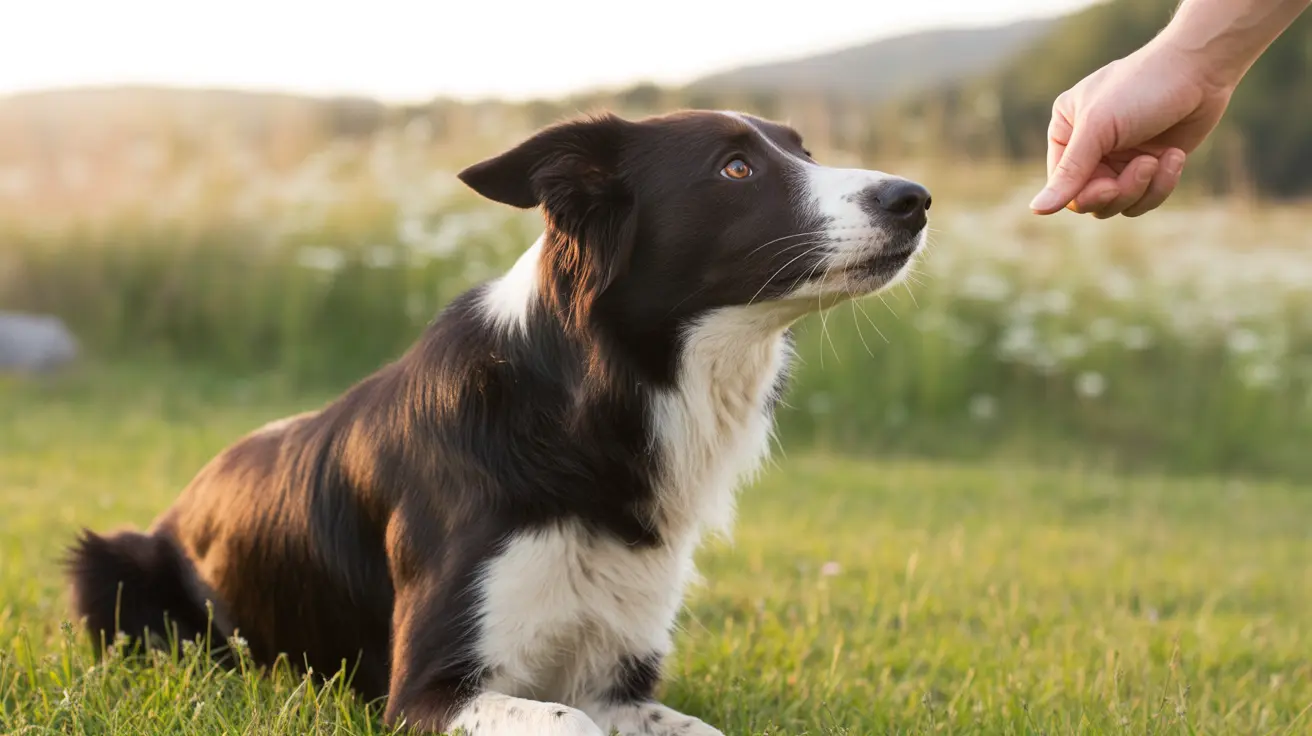Visual Cues for Dog Training: The Ultimate Guide to Non-Verbal Communication with Your Dog
Dogs are remarkable visual learners who naturally respond better to physical gestures and body movements than spoken words. While we humans rely heavily on verbal communication, our canine companions interpret the world primarily through what they see, making visual cues for dog training an incredibly powerful tool for building stronger relationships and achieving better obedience. Understanding how to effectively use hand signals and body language can transform your training sessions and create clearer communication pathways with your furry friend.
Research has shown that dogs achieve up to 99% accuracy when responding to hand signals compared to only 82% accuracy with verbal commands alone. This remarkable difference highlights the importance of incorporating visual training methods into your dog's education. Whether you're working with a young puppy just starting their training journey or an older dog who may be experiencing hearing difficulties, mastering visual cues for dog training will enhance your communication and strengthen the bond you share with your pet.
The Science Behind How Dogs Interpret Visual Cues
At least 80% of human communication occurs through body language, and this principle applies even more strongly to our canine companions. Dogs are naturally wired to process visual stimuli more efficiently than auditory commands, resulting in faster neural learning and more reliable responses. This biological advantage stems from their evolutionary development as pack animals who relied heavily on visual communication for survival and coordination.
Interestingly, breed characteristics significantly influence a dog's ability to respond to visual cues. Studies comparing different working dog breeds have revealed that cooperative working breeds—those bred to work alongside humans—significantly outperform independent working breeds in following visual signals. Breeds like Australian Shepherds, Border Collies, German Shepherds, Labradors, and Golden Retrievers excel at interpreting human gestures, while independent breeds such as Beagles, Bloodhounds, and Siberian Huskies show less consistent responses.
Additionally, facial structure plays a crucial role in visual perception. Short-nosed (brachycephalic) breeds like Pugs, Bulldogs, Boxers, and French Bulldogs respond better to visual cues than long-nosed (dolichocephalic) breeds such as Afghan Hounds, Dachshunds, and Irish Setters. This difference occurs because brachycephalic breeds have more centrally located retinal ganglion cells, resulting in better focus on central visual stimuli and improved ability to process hand signals and facial expressions.
Essential Hand Signals Every Dog Should Know
Learning the fundamental hand signals forms the foundation of successful visual cue training. These seven essential gestures will cover most everyday situations and provide a solid communication framework between you and your dog.
Basic Command Signals
The Sit command uses a palm-up gesture swept upward in an arc motion. This natural lifting movement mimics the luring motion used with treats and helps dogs understand the upward direction you want them to move. For the Down command, extend your palm downward and move your hand straight down toward the floor, clearly indicating the direction you want your dog to go.
The Stay signal requires holding your palm forward like a stop sign, keeping it steady and still to communicate the concept of remaining in position. For Come, extend your arm outward then sweep it toward your chest in a clear gathering motion that invites your dog to approach you.
Attention and Behavioral Signals
Teaching your dog the Watch Me or Focus command involves pointing your index finger directly to your eye, drawing their attention to your face and establishing eye contact. This signal is particularly valuable for redirecting attention and maintaining engagement during training sessions.
The Leave It command uses a sharp sideways hand wave that clearly communicates "no" or "stop" without confusion. Finally, the Go to Place signal employs a sweeping underhand motion pointing toward the designated mat or location where you want your dog to settle.
Step-by-Step Guide to Teaching Visual Cues
Successfully introducing visual cues for dog training requires a systematic approach that builds understanding gradually. The most effective method follows a three-step progression that ensures your dog fully grasps each signal before moving to the next level of complexity.
The Foundation Phase: Luring with Treats
Begin by using a treat in your hand to lure your dog into the desired behavior while simultaneously performing the hand signal. This initial phase creates a positive association between the visual cue and the reward, establishing the basic connection your dog needs to understand what you're asking. Keep the treat visible during this phase, as it serves as both motivation and guidance for the correct response.
The Pairing Phase: Adding Verbal Commands
Once your dog consistently responds to the lured gesture, begin pairing the hand signal with the verbal command. Use both the visual cue and the spoken word simultaneously, allowing your dog to connect the two forms of communication. This dual-input approach reinforces learning and provides backup communication methods when needed.
The Independence Phase: Fading Verbal Cues
Gradually reduce reliance on verbal commands while maintaining the hand signals. Start by lowering the volume of your voice, then move to mouthing the words silently, and finally eliminate the verbal component entirely. This progression allows your dog to develop confidence in responding to visual cues alone, creating truly independent communication.
The Importance of Persistent Visual Cues
One of the most common mistakes in visual cue training involves inconsistent or fleeting hand signals. Dogs need persistent visual cues to understand and process commands effectively. When trainers quickly remove their hand signals before the dog has time to respond, it creates confusion and slows the learning process.
Think of this concept like solving math problems under time pressure—if the visual information disappears before your dog can process and respond, the training becomes unnecessarily difficult. Maintaining steady, clear hand signals gives your dog the time they need to interpret the command and execute the desired behavior successfully.
Practice holding your hand signals steady for several seconds, allowing your dog to see and process the visual information fully. This patience and consistency will result in faster response times and more reliable obedience as your dog becomes comfortable with the visual cues for dog training system.
Troubleshooting Common Visual Cue Training Challenges
When dogs fail to respond to visual signals, several common issues may be interfering with their learning process. Understanding these obstacles and their solutions will help you maintain progress and avoid frustration during training sessions.
Avoiding Unintentional Cues
Dogs quickly pick up on routines and visual patterns, sometimes responding to unintended signals rather than your deliberate hand commands. Common problems include reaching into your pocket before giving a command, which teaches dogs to watch for treat preparation rather than actual signals. Keep rewards out of sight until after your dog performs the desired behavior, then mark the success with a clicker or verbal marker before providing the treat.
Managing Mixed Signals
Inconsistency in hand signals confuses dogs and undermines training progress. Ensure all family members use identical gestures for each command, and avoid combining conflicting visual messages. For example, don't use different hand positions for the same command or accidentally give opposing signals with your body language while presenting hand cues.
Building Active Thinking
Some dogs become overly dependent on seeing treats or rewards before responding to commands. Use shaping techniques that reward incremental progress toward the desired behavior, and employ controlled luring that gradually reduces the visibility of rewards. This approach develops active, thinking dogs that respond to visual cues because they understand the communication, not just because they see food.
Visual Cues vs. Verbal Commands: Training Efficiency Comparison
The effectiveness of visual cues for dog training becomes apparent when comparing response rates and learning speeds between visual and verbal communication methods. Dogs demonstrate significantly higher accuracy rates with hand signals, achieving up to 99% success compared to 82% with verbal commands alone.
Visual stimuli also result in faster neural learning, meaning dogs acquire new behaviors more quickly when taught through hand signals rather than voice commands. This efficiency stems from dogs' natural ability to process visual information and their evolutionary reliance on body language for pack communication.
Additionally, visual cues prove invaluable in challenging environments where verbal commands may be ineffective. Noisy parks, crowded events, or situations requiring quiet behavior all benefit from silent hand signal communication. This versatility makes visual cue training an essential skill for well-rounded dog obedience.
Adapting Visual Cue Training for Dogs with Special Needs
Visual cues for dog training become particularly crucial when working with dogs who have hearing impairments or other special needs. Senior dogs who may be losing their hearing can maintain obedience and communication through hand signals, preserving their quality of life and strengthening their relationship with their owners.
For deaf dogs or those with significant hearing loss, visual cues represent the primary communication method available. These dogs often become exceptionally skilled at reading body language and hand signals, sometimes surpassing hearing dogs in their responsiveness to visual commands.
When training dogs with visual impairments, focus on consistent spatial positioning and use gentle touch cues combined with scent markers to create alternative communication pathways. Even dogs with both hearing and vision challenges can learn through tactile signals and consistent routine patterns.
The Role of Body Language and Posture in Dog Communication
Effective visual cue training extends far beyond hand signals to encompass your entire body language and posture. Dogs read human body language continuously, interpreting confidence, energy levels, and intentions through subtle physical cues that we may not even realize we're providing.
Your stance communicates authority and intention—standing tall and confident signals leadership, while slouching or uncertain posture may undermine your commands. Similarly, your energy level affects your dog's responsiveness; calm, controlled movements typically produce better results than frantic or overly excited gestures.
Eye contact plays a crucial role in visual communication, with the "Watch Me" command serving as a foundation for other training. However, be mindful that direct staring can be interpreted as confrontational by some dogs, particularly those who are anxious or dominant. Learn to read your dog's comfort level and adjust your body language accordingly.
Real-World Applications of Visual Cue Training
The practical benefits of mastering visual cues for dog training become evident in numerous everyday situations. At dog parks or other social environments, silent hand signals allow you to communicate with your dog without disrupting other animals or people. During agility training or competitive events, visual cues provide precise direction without the confusion that verbal commands might create in noisy environments.
Travel situations particularly benefit from visual communication—whether you're in a quiet hotel lobby, on public transportation, or visiting friends who prefer minimal barking, hand signals maintain control while respecting social boundaries. Veterinary visits also become less stressful when you can provide reassurance and direction through calm visual cues rather than potentially anxiety-inducing verbal commands.
Home life improves significantly when both family members and guests can communicate basic commands to your dog through simple hand signals. This universal communication method creates consistency regardless of who is interacting with your pet, reinforcing training and maintaining behavioral standards.
Frequently Asked Questions
- Q: At what age can I start teaching visual cues to my dog?
A: You can begin training visual cues as early as 8 weeks old. Puppies are naturally receptive to visual learning, and starting early establishes good communication patterns. However, older dogs can also learn visual cues successfully with patience and consistent practice. - Q: How long does it typically take for a dog to learn hand signals?
A: Most dogs can learn basic hand signals within 2-4 weeks of consistent daily practice. However, the timeline varies based on the dog's breed, age, previous training experience, and individual learning capacity. Cooperative working breeds typically learn faster than independent breeds. - Q: Can I teach visual cues to a dog that already knows verbal commands?
A: Yes, you can easily add visual cues to existing verbal commands by pairing them together during training sessions. Start by using both the verbal command and hand signal simultaneously, then gradually fade the verbal cue while maintaining the visual signal. - Q: What should I do if my dog ignores my hand signals?
A: If your dog ignores visual cues, return to the luring phase with treats to re-establish the connection between the signal and the desired behavior. Ensure you're holding the signal steady long enough for your dog to process it, and check that all family members are using consistent hand positions. - Q: Are certain dog breeds better at learning visual cues than others?
A: Yes, cooperative working breeds like Border Collies, German Shepherds, and Labrador Retrievers typically excel at visual cue training. Additionally, short-nosed breeds often respond better to visual signals than long-nosed breeds due to their retinal structure and central visual focus. - Q: How do I prevent my dog from becoming dependent on seeing treats during visual cue training?
A: Keep treats out of sight until after your dog performs the desired behavior, then mark the success with a clicker or verbal marker before providing the reward. Use shaping techniques to reward progress gradually, and practice with controlled luring that reduces treat visibility over time. - Q: Can visual cues replace verbal commands entirely?
A: While dogs often respond more accurately to visual cues than verbal commands, it's beneficial to maintain both communication methods. Visual cues excel in noisy environments or when quiet behavior is required, while verbal commands can be useful when your dog isn't looking at you or in low-light situations.
Conclusion
Mastering visual cues for dog training opens up a new dimension of communication that can significantly improve your relationship with your canine companion. The science clearly demonstrates that dogs respond more accurately and learn more quickly through visual signals than verbal commands alone, making hand signal training an invaluable skill for any dog owner. By understanding how dogs interpret visual information, learning the essential hand signals, and applying consistent training methods, you can create a more effective and harmonious partnership with your pet.
Remember that success with visual cue training requires patience, persistence, and consistency. Whether you're working with a young puppy eager to learn or an older dog adapting to new communication methods, the investment in visual training pays dividends in improved obedience, stronger bonding, and enhanced quality of life for both you and your dog. Start with basic signals, practice regularly, and celebrate the progress as you and your dog develop this powerful form of non-verbal communication together.






